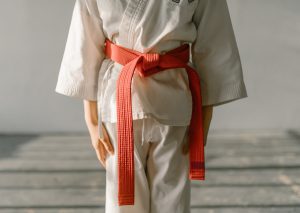
Judo, a martial art known for its rich heritage and disciplined approach, offers a fascinating exploration through its ranking system, primarily symbolized by the various colors of judo belts. Belt ranks, represented by coloured belts, are an essential part of judo, indicating students’ progression in skill and knowledge, with higher ranks demonstrating greater proficiency. At NOCO Jiu-Jitsu and Self-Defense, understanding the significance of each belt is part of adopting the deeper values of judo. This guide explores the world of judo belts, examining their ranks, colors, and the profound meanings behind them.
The Beginning: White and Yellow Belts

The odyssey in judo begins with the white belt, a symbol of purity and the absence of knowledge, much like a blank canvas. Beginners at NOCO Jiu-Jitsu and Self-Defense wear this belt as they commence their judo education, learning the fundamentals. As practitioners progress, they graduate to the yellow belt. This color represents the first rays of sunlight, illuminating the path of knowledge and skill in judo. It’s a phase where students start solidifying their basics and understanding the principles of balance and stability. This stage also introduces elements shared with other martial arts, emphasizing the importance of physical activity and mental discipline.
The Path of Learning: Orange Belts

As students progress, they earn the orange belt. This color signifies growing strength and the development of foundational judo skills. At this stage, students at NOCO Jiu-Jitsu and Self-Defense begin to refine their techniques and understand judo’s strategic aspects. The green belt follows a color that reflects growth and capability. Here, judokas start to hone their skills, developing proficiency in various throws and holds. This progression mirrors the structured growth seen in other grappling-based martial arts like Brazilian Jiu-Jitsu (BJJ), which also emphasizes practical self-defense skills.
Intermediate Mastery: Blue Belts

The blue belt marks a significant transition to advanced techniques and a deeper understanding of judo’s philosophical aspects. Students wearing the blue belt at NOCO Jiu-Jitsu and Self-Defense demonstrate improved proficiency and begin to assist beginners, sharing their knowledge. The purple belt, often seen as a bridge between the intermediate and advanced levels, symbolizes the deepening of judo wisdom. It’s a stage where practitioners refine their techniques and begin to explore more complex aspects of judo. These stages also introduce concepts like joint locks and stress relief, which are common in martial arts training.
The Advanced Stages: Brown and Black Belts

Achieving a brown belt indicates a high level of proficiency and understanding of judo, requiring years of dedicated training. At NOCO Jiu-Jitsu and Self-Defense, brown belt holders are recognized for their dedication and skill. They are expected to exhibit not only technical expertise but also the principles of respect and honor intrinsic to judo. This phase often emphasizes advanced grappling techniques and ground fighting strategies, essential for mastering a grappling-based martial art.
The black belt is the pinnacle in the judo belt system, signifying expertise and mastery in grappling techniques among others. Higher-level black belts, known as degree black belts, represent advanced ranks such as 9th dan and 10th dan, highlighting the practitioner’s significant contribution and skill. However, in judo, the learning never stops. Black belt holders continue to refine their skills and contribute to the judo community, embodying the values of discipline, respect, and continuous improvement. At this level, the focus often includes comparing techniques with those of striking-based martial arts like karate, highlighting the diversity in training methods.
How Long to Achieve a Judo Black Belt

Achieving a judo black belt typically requires several years of dedicated training, reflecting a deep commitment to mastering both the physical techniques and philosophical aspects of the martial art. The exact time can vary widely among individuals, depending on factors such as the frequency of training, personal aptitude, and the specific requirements of their judo school. On average, it takes about 5 to 10 years for a practitioner to progress through the various belt colors—from white to black—each rank encapsulating a significant phase of learning and personal growth.
Beyond Black: Dan Ranks

Beyond the degree, black belt, judo practitioners can achieve Dan ranks, which represent higher degrees of expertise and contribution to the sport. The red belt is significant for higher Dan ranks, indicating mastery and competence in the art of judo. These ranks are awarded based on a combination of skill, knowledge, teaching abilities, and overall contribution to judo.
NOCO Jiu-Jitsu and Self-Defense: A Community of Learning and Growth

At NOCO Jiu-Jitsu and Self-Defense, judo schools play a crucial role in the progression through the various judo belts, which is more than just a succession of ranks. Many judo schools have their unique curriculum, testing requirements, and promotions based on the belt system, emphasizing the importance of a structured learning journey. It’s a path of personal growth, discipline, and community. Each belt color not only represents a level of skill but also a stage in the practitioner’s personal and spiritual evolution in judo.
The Significance of Each Rank in Judo’s Philosophy

Judo techniques are not just physical maneuvers; they are a gateway to understanding the philosophical depth of judo, emphasizing the defensive nature of the martial art and its life-enhancing aspects. In judo, each belt is more than just a rank; it’s a symbol of the judoka’s path, both on and off the mat, requiring the development of martial arts skills at each stage. At NOCO Jiu-Jitsu and Self-Defense, we emphasize that each belt color represents a phase in this path, incorporating not only physical skills but also mental and emotional growth. The transition from one belt to another is not just about mastering techniques; it’s about evolving as a person and embodying judo’s values like respect, humility, and perseverance.
Training Methodologies at Each Stage

At NOCO Jiu-Jitsu and Self-Defense, training methods evolve with each belt. For beginners, the focus is on basic movements and falls, ensuring safety and a solid foundation. As judokas progress to intermediate belts, training includes more dynamic techniques, sparring sessions, and tactical skills. This aligns with the principles seen in karate training, which emphasizes developing striking skills, such as knee and elbow strikes, alongside defensive strategies. Advanced belts engage in more rigorous training, focusing on perfecting techniques, developing strategic thinking, and understanding the nuances of competitive judo. Compared to other popular martial arts, judo’s training methodologies emphasize a balanced progression, blending physical conditioning with strategic skill development.
The Role of Competitions and Gradings

Competitions and grading are integral to the judo experience. Nage no kata is an essential skill for belt promotions. They are not just tests of skill but opportunities for growth and self-reflection. At NOCO Jiu-Jitsu and Self-Defense, we encourage our students to participate in tournaments, as they offer invaluable experiences in dealing with pressure, sportsmanship, and resilience. Gradings, on the other hand, are milestones where judokas demonstrate their proficiency and readiness to advance to the next level.
The Community Aspect of Judo

Judo is not just an individual sport; it’s a community. At NOCO Jiu-Jitsu and Self-Defense, we foster a sense of camaraderie and mutual respect among our students. The dojo is a place where people from diverse backgrounds come together, united by their love for judo. This sense of community extends beyond the dojo, as judokas carry the values learned in judo into their everyday lives.
Judo’s Impact Beyond the Mat

The impact of judo extends far beyond physical skills. It shapes character, instills discipline, and promotes a healthy lifestyle. The principles learned through the judo belt system – such as respect, courage, and honor – are applicable in all areas of life. For martial artists who choose jiu-jitsu or other martial arts, the emphasis may shift toward either striking skills or grappling techniques, but the underlying philosophy remains one of personal growth and problem-solving skills.
At NOCO Jiu Jitsu and Self Defense, we take pride in seeing our students apply these values in their personal and professional lives, embodying the true spirit of judo.
A Lifelong Adventure

In conclusion, the world of judo belts at NOCO Jiu-Jitsu and Self-Defense is a voyage of continuous learning and personal development. Each belt, each color, tells a story of hard work, dedication, and growth. As judokas progress through the ranks, they not only improve their judo skills but also evolve as individuals, embodying the rich values and traditions of this esteemed martial art. The voyage through the judo belts is, indeed, a comprehensive guide to personal excellence.
Begin Your Judo Journey Today at NOCO Jiu-Jitsu and Self-Defense!

Start your journey into martial arts with our comprehensive judo programs. Whether you’re a beginner ready to earn your white belt or an advanced practitioner working toward higher dan grades, our experienced instructors are here to support you every step of the way. Develop physical fitness, mental discipline, and practical self-defense skills while becoming part of a welcoming and encouraging community.
Sign up now and take the first step towards mastering the art of judo. Your path to confidence, skill, and growth begins here!
FAQs on Judo Belts: Understanding Ranks, Colors, and Their Meanings
How long does it typically take to progress from one belt to another in judo?
The time it takes to progress from one belt to another varies depending on the individual's dedication, training frequency, and personal growth. At NOCO Jiu-Jitsu and Self-Defense, like most dojos, progression is based on skill level, knowledge, and demonstration of judo principles, rather than a fixed timeline.
Are there age requirements for different judo belts?
Yes, in judo, certain belt levels have age requirements, especially for higher ranks. This ensures that practitioners have not only the technical skills but also the maturity to understand and embody the principles associated with each rank.
Can a judoka skip belt colors?
It's rare for judokas to skip belt colors, as each belt represents a crucial stage of development. However, exceptions can occur, typically in cases where a judoka has prior experience or demonstrates exceptional skill and understanding.
What is the significance of the black belt in judo?
The black belt in judo is a significant achievement, with the black belt indicating a high level of competence and understanding in judo. It symbolizes not just technical skill, but also maturity, discipline, and a deep commitment to the values of judo. Achieving a black belt is often seen as the beginning of a deeper exploration into judo's teachings.
How does NOCO Jiu-Jitsu and Self-Defense approach belt progression?
At NOCO Jiu-Jitsu and Self-Defense, belt progression is approached with a focus on comprehensive development. This includes technical skills, understanding of judo principles, and personal growth. We emphasize respect, discipline, and continuous learning at every stage of the adventure.
What role do competitions play in belt progression?
Competitions play a significant role in demonstrating a judoka's skills and readiness for belt progression. They provide opportunities for practical application of techniques, sportsmanship, and handling pressure, all of which are important for advancement.
What happens after achieving a black belt in judo?
After achieving a black belt, judokas can pursue higher Dan ranks, which represent deeper levels of understanding, skill, and contribution to judo. This often involves further training, teaching, and involvement in the judo community.
Can belts be lost or demoted in judo?
In judo, belts are rarely demoted as they represent a judoka's highest achieved level. However, maintaining the standards of conduct and skill associated with each belt is expected, as judo is as much about character and discipline as it is about physical skill.




